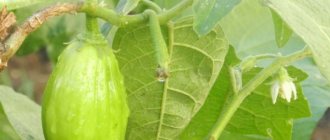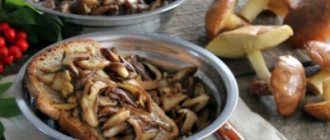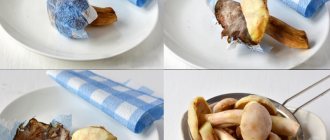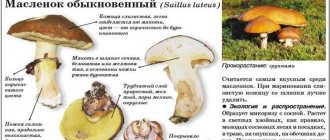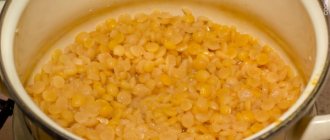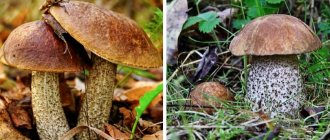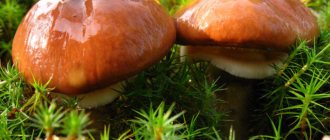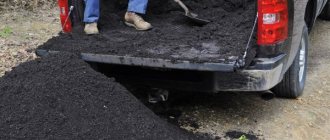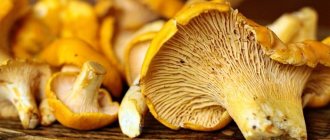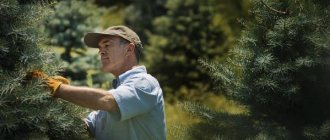How to cook butter without turning brown
It is recommended to boil the product before any further use:
- before frying;
- freezing;
- slicing for salads;
- for soup.
To prevent the butter from darkening during cooking, there are several tips for the housewife:
- Mushroom raw materials should be kept in boiling water for no more than 30 minutes.
- Before frying, boiling time should be reduced to 15 minutes.
- It is important to first defrost the frozen preparation, and then cook it in the same way as fresh mushrooms.
- Before freezing, the butter must be boiled a little, dried, and put into bags. It is permissible to harvest raw fruits.
- When preparing soup, the first water must be drained, and the base of the dish will be the following broth. Boiling time should not exceed 30 minutes.
- When cooking, add 1 tsp. citric acid.
- It is recommended to simmer butter in a slow cooker for about 40 minutes.
There is no need to worry if the butter mushrooms turn purple after cooking: all the taste characteristics of the mushrooms will remain unchanged, and the dish will turn out just as appetizing as usual.
Color changing mushrooms
In nature, there is one such species - the goat or lattice. This mushroom is a representative of the Buttercup genus and has a yellowish-brown cap covered with mucus, the circumference of which varies from 3 to 12 cm, depending on age.
At the beginning of growth, the surface of its cap is cushion-shaped, later it becomes flat, smooth and sticky.
The leg is 10 cm long, not too thick - up to 2 cm, elastic, cylindrical, a couple of shades lighter than the head, matte. In cross-section, the fruit body is light, does not lose any smell or aroma, and is dense.
If after cooking such mushrooms become dark lilac or purple in color, do not worry, this is a common occurrence.
Why do mushrooms turn dark?
It happens that during cooking the caps and stems change color. The fact is that there are several subspecies of these mushrooms:
- if boiled boletus mushrooms turn purple, then most likely it is goat (cow, dry butterdish), it is quite edible and not dangerous;
- if the mushrooms turn red during cooking, then these are flywheels, also edible mushrooms;
- if the collected mushrooms turn pink after cooking, then this is most likely a mushroom, which also belongs to the subspecies of edible butter mushrooms.
If you are going to prepare mushrooms for the winter, then remember that pickled or frozen boletus, previously boiled in water with the addition of citric acid, will remain light in color and will not color the marinade.
False boletus can also change color when cut, but they differ from real ones primarily in that the false ones have plates rather than a sponge under the cap. Based on this feature, you will not pick up inedible or poisonous ones in the forest. But remember that it is better to double-check yourself several times before eating any mushroom.
Why do boletus turn purple when cooked?
Every mushroom picker should know that this variety of mushrooms usually does not change color after heat treatment. During the boiling process, it is not characterized by the appearance of blue, lilac, or brown shades.
If the butter dish turns purple during cooking, this indicates that the cooking method was incorrectly chosen. The stems and caps darken from too much heat treatment. When heated for a long time together with water, vegetable protein is destroyed, and boiled mushroom raw materials develop an unusual blue color. Such a change may also depend on the area of growth, when the composition of the soil and illumination can affect the course of chemical reactions during heat treatment.
Pickled boletus turns purple when cooked due to numerous additives in the form of spices, garlic, onion, and pepper. To avoid this, you need to boil the product several times, and be sure to drain the first water. It is recommended to add vinegar and a pinch of citric acid to the marinade.
Other mushrooms are the first reason why boletus darkens during heat treatment
The main reason for the sudden change in color of mushrooms to dark or purple after cooking is the inclusion of other species in the basket that are similar in appearance to boletus. Among the doppelgängers we can distinguish kids (goats, or reshetniks), which are easily confused when collected. This is also an edible variety, which tastes almost no different from the “original”.
Other forest plants also have the ability to change color, including:
- Mosswort
- Grabovik
False boletus turns black already at the cleaning stage. They differ from real representatives by a different structure of the cap: under it there is not a sponge, but plates.
Violation of cooking rules is the second reason why the butter turned purple
The oiler turns purple due to improper processing technology. In order for the product to retain its original appearance after boiling, you need to prepare it following simple rules:
- large ripe fruits are cleared of film;
- legs and caps are brought to a boil in clean water;
- boil for no more than 5 - 10 minutes;
- Drain the mushroom mass in a colander;
- pour salted water, after boiling, cook for 15 - 25 minutes, depending on the size of the fruit.
During the cooking process, a film may appear on the surface, which must be removed with a slotted spoon. The recommendation to change the water is due to the fact that, as decomposers, boletus absorbs radiation and heavy metals, but during the first boiling they are destroyed.
Should I worry if the butter turns purple during cooking?
Inexperienced mushroom pickers are alarmed by the fact that the collected prey changes its color to purple when the dishes are cooked. This may well happen to edible specimens if you cook them for more than a quarter of an hour. Do not worry if the selected product has all the varietal characteristics. Purple butter, obtained after cooking, does not threaten human health and retains its usual taste.
Delicious boletus and their inedible counterparts
Does the oiler have inedible or poisonous counterparts? The usual types of boletus are delicious mushrooms. They have a characteristic cap. Only the yellow-brown buttercup, whose flesh turns slightly blue when cut, can disappoint gourmets due to its mediocre taste. Some Western reference books define it as inedible (but not poisonous!). Siberian oiler is also considered a non-toxic, inedible mushroom.
There are no poisonous butterflies in our forests. But it is quite possible to confuse the delicious butter dish with the pepper mushroom (Suillus piperatus). This mushroom is called: pepper butterfly. It contains bitterness, but is not poisonous. Mushroom pickers who put pepper butter in the basket say in their defense that the bitter taste is greatly reduced when cooked for 15 minutes. After this, the mushroom is fried along with other mushrooms. Pepper oil grows not only next to pine trees, but also in spruce and deciduous forests.
Causes of pinkness
All mushroom pickers who begin processing the harvest after harvesting should remember that boletus mushrooms will never turn red or pink during heat treatment.
Did you know? Butter mushrooms can slightly change their color towards dark blue only when cut due to a reaction with air; at all other stages of processing, these mushrooms, on the contrary, lighten, while keeping the broth also light.
If this fact manifests itself, and reddened specimens are found in the water during cooking, then these are twin mushrooms belonging to the same family as boletus - the so-called goat mushrooms. They contain a substance that can change the color of mushrooms when boiled. Even experienced mushroom pickers cannot immediately distinguish closely related boletus species, since they grow in pine forests at the same time and have the same chemical composition.
If the crop turns partially pink during cooking, do not be upset, since baby goats, like all baby goats, are harmless and do not particularly differ in taste . The only problem in this situation is the unappetizing appearance of the finished dish, however, this can also be used as an original addition.
How to clean
Boletus mushrooms are distinguished from other mushrooms by a special oily film on the surface of the cap, which is why they got their name. Do I need to clean it off? It all depends on how you are going to prepare the butter:
- if you are going to boil or fry freshly picked mushrooms, then you should peel off the film only from adult large mushrooms; you can leave it on young ones;
- Before salting, pickling or freezing, it is better to remove the film from all mushrooms, as it can give a slight bitterness to the finished dish.
The bottom film and sponge under the cap also need to be removed. Then sort the mushrooms, cut out the damaged areas with a knife, cut them into pieces - and you can cook.
Time and place of fruiting
The fireweed mushroom forms mycorrhiza with pine and grows singly or in large groups. For habitat it prefers acidic nutrient soils, damp places, grows in swamps or on roadsides. The lattice mushroom is widespread in the northern temperate zone of Europe, the European part of Russia, the North Caucasus, the Urals, Siberia, and the Far East.
Reference! The name “goat’s mushroom” (the mushroom is also called “cow’s mushroom”) was given to the mushroom for its place of growth - it is easy to find in meadows where cattle graze.
How to buy mushrooms correctly
A few words about buying mushrooms at the market. If you don’t have the time or skills to pick mushrooms yourself, you can buy them at the market.
- When purchasing, you need to carefully examine the mushrooms - what condition they are in, whether there are any bruises or damage.
- Do not buy mushrooms that have been pulled out by the roots. Firstly, a person picking mushrooms thus spoils the mycelium, which means he absolutely doesn’t care what grows there after him, and, most likely, he doesn’t care what mushrooms he sells. Secondly, such an incompetent seller can slip (not on purpose, of course) poisonous mushrooms.
- Look at the cut of the leg. It should be fresh, not weathered, the edges should be smooth and not bent.
- The caps should not have any dents or darkened brown spots. If the mushrooms are limp, you should not buy them. At best, they will be tasteless.
- Do not buy mushrooms in plastic bags. This way they spoil very quickly. If they were collected directly into the bag, then they are probably no longer suitable.
We suggest you read: Why do spider mites appear on cucumbers and what to do about it?
If trouble does occur, you should immediately contact a medical facility by calling an ambulance. Before the ambulance arrives, your actions can not only alleviate the suffering of the victim, but also save his life. Act clearly and quickly:
- Don't panic.
- Perform gastric lavage and induce artificial vomiting several times.
- The victim should be placed comfortably in a horizontal position and covered with a blanket.
- Drinking regularly will help prevent dehydration and fight toxins. To do this, you need to drink milk, salted or just clean water.
- Someone should always be near the patient to ensure that the victim is conscious and give ammonia to sniff in case of loss of consciousness, otherwise a coma may occur.
Useful properties and restrictions on use
The row is rich in B vitamins, as well as manganese, copper and zinc. This species is actively used not only in cooking, but also in medicine, because cyanosis is used for the production of antibiotics and antifungal agents.
In addition, cyanosis reduces glucose levels and has an anti-inflammatory and immunostimulating effect. Cobweb has similar beneficial properties as cyanosis, since it contains identical beneficial substances and trace elements.
Gossamer violet
Petsitsa, in turn, has a positive effect on clarity of vision, thins the blood and thereby prevents the appearance of varicose veins and thrombophlebitis. Pepper tincture is used to treat kinetosis. Petsica also contains a large amount of vitamin C, which improves human immunity.
Mushrooms should not be abused by people with gastrointestinal diseases. And in case of serious diseases, such as ulcers, gastritis, pancreatitis, you should completely stop using them. Also, this product should not be consumed by children under 10 years of age and pregnant women, since it is quite difficult to digest and absorb by the body.
| Name: | Butter |
| Type: | Edible |
There may be several reasons why boletus turned purple after cooking. To understand what the color change means and whether something can be done, you need to understand the characteristics of these mushrooms.
Summer oiler, grainy
Summer butterwort (Suillus granulatus) is also productive. It is suitable for fresh use (it is fried, boiled and stewed), drying, salting and pickling. The mushroom is collected in the summer (June - July) in coniferous forests, where there are many pine trees. Some summer boletus appear from the end of May.
Hat. The shape of the mucous cap (up to 10 cm in diameter) is convex in young mushrooms, and flat in adults. The skin color ranges from yellowish-brown to ocher-brown. The tubular layer is yellow or light yellow.
Cap flesh. The color of the thick pulp is yellowish-white. It has a pleasant taste and smell.
Leg. The height of the solid cylindrical leg is up to 8 cm, thickness is up to 2 cm. The color is yellowish. The leg has a granular surface (hence the name of the species). There is no ring on the leg, which is a distinctive feature of the species. Small watery drops protrude from the upper part of the stem.
Characteristics, composition and description of the mushroom
The goat is a tubular mushroom of the genus Suillus (Oil Can), family Suillaceae (Oil Can), order Boletales (Boletaceae). It also has popular names: Reshetnyak, Dry butterdish, Goat mushroom, Ivanchik, Korovik, Cow mushroom, Mullein. Latin names: Suillus bovinus, Boletus bovinus.
The diameter of the cow's cap varies from 4 to 12 cm. It has a brown, reddish or brown color, sometimes with a reddish tint. At a young age it is slightly swollen, but over time it straightens and becomes even. Smooth to the touch, without cracks or bumps. The skin fits tightly to the cap and is difficult to remove.
The hymenophore (lower part of the cap) is tubular, yellowish or brownish in color, slightly lighter than the cap and stalk. The tubular layer is descending, the pores are yellowish. The spore powder is light brown and olive yellow.
Goat mushrooms have dense, elastic flesh, which becomes rubbery over time. The color of the pulp is pale yellow or light yellow. In the stem it is reddish, brownish, and when cut it turns red or pink. It does not have a pronounced odor, the taste is weak, it gives off a sour taste.
Important! After heat treatment, the flesh of the goat turns pinkish-purple.
The leg reaches a height of 4-10 cm, its thickness is 1-2 cm. It has a solid cylindrical shape, often curved, tapering downward. Its surface is smooth, matte, the color matches the cap or is slightly lighter. The base is yellow.
A little history
German traveler and botanist Otto Kunze first described goat's mushrooms and gave the species a binomial name in 1898.
Late oiler (real, ordinary, yellow)
Late oiler (Suillus luteus) is also called true, ordinary, yellow. In Central Russian forests this is the most common species. The name of the mushroom can be misleading, since late oiler does not appear in late autumn, but from June to October. True, the time of mass collection actually occurs in the fall (in some years even in November). Late oiler is a mushroom of pine forests. It can also be found in places where, in addition to pines, there are other coniferous trees.
Late butterwort is very productive, it grows in large groups. This mushroom is prepared fresh (fried, boiled, stewed), dried, salted and pickled.
Hat. The shape of the mucous cap (up to 12 cm in diameter) in young fungi is cushion-convex and hemispherical. In adults it is wide-conical. Its edges are down. The surface color of the cap is chestnut brown, red-brown or dark brown. The tubular layer is golden yellow or lemon yellow in color. Old mushrooms develop an olive tint.
Cap flesh. The color of the thick pulp is white or yellowish. It has a pleasant smell and a slightly sour taste.
Leg. The height of the solid cylindrical stem of the late butterdish is up to 10 cm, thickness - up to 2 (3) cm. In adult mushrooms it has a white or grayish-violet ring. Above it the color of the leg is white, below it is brownish.
We suggest you familiarize yourself with Lemon for the liver: benefits and harm
Places where purple mushrooms grow in the Moscow region
Spider webs can be found in coniferous and deciduous forests near pine, birch, oak, beech and spruce. On the territory of the Russian Federation it grows in the Primorsky and Krasnoyarsk Territories, but recently the spider web can also be found in the Moscow region.
Lilac lacquer usually grows on well-moistened soils in coniferous forests near moss. But it can also be found in mixed and deciduous forests not far from oak trees.
Lilac lacquer
Petsica, in turn, grows exclusively in areas after fires or bonfires and, as a rule, grows in large groups. The mushroom is widespread not only in the Moscow region, but throughout Europe and North America, although even there it is quite rare.
Rowing is common in the temperate zone of the Northern Hemisphere, which corresponds to Siberia and the European part of Russia. It is a saprophyte and grows on rotting leaves, fallen needles and compost heaps. The row can be found in coniferous, mixed forests and even gardens. Blueberry tolerates the first frosts quite well, so it can bear fruit until November. The row most often grows in groups, and sometimes forms “witch circles”.
Mushroom recipes: fresh butter soup
It is not necessary to boil the mushrooms before freezing; you can fry and freeze them fresh (the skin under and above the cap must be removed), but the boiled ones produce compact briquettes that are convenient to store in the freezer. And from the water in which the mushrooms were boiled, you can make a delicious boletus soup.
To prepare it, take boletus, potatoes, carrots, fresh herbs, onions, vegetable oil, and salt to taste. Peeled, prepared fruits need to be filled with water, boiled after boiling for a few minutes, then strain through a colander. Next, add new water, add salt, and cook for about 20 minutes, skimming the foam from the surface.
Place peeled, washed, chopped potatoes into the mushroom broth, boil, add herbs and spices, and simmer for 10-15 minutes. Place the fried boletus and vegetables into the broth and cook the mushroom soup until the potatoes are fully cooked, then turn off the heat. Cover the finished fresh butter soup with a lid and let it brew for a few minutes. Serve with sour cream and fresh bread.
Growing at home and in the country
Since cowweed is a mycorrhizal fungus and grows close to coniferous trees, therefore, it is very desirable that young pine, cedar or spruce grow on the site.
Important! Goats, like their closest relatives, cannot live without a patron tree.
Cultivation of goat kids occurs in several stages:
- Soil preparation. In the selected area (preferably in partial shade), the top soil layer is removed. Since the correct growing technology requires the formation of several layers of soil, plant materials, for example, chopped wood, grass, foliage, and pine needles are placed in the first layer. For the second layer, you need to use soil collected from the areas where the kids grow, then it will have an acid-base balance that is as close as possible to the optimal one. You can take ordinary garden soil. If necessary, humus should be added to it. Baby goat mycelium is sown on the prepared soil.
- Inoculation of mycelium. You can purchase it in specialized stores or prepare it yourself from old mushroom caps. To do this, you need to collect adult, overripe specimens and mix them with a substrate prepared from a mixture of pine sawdust and peat. The dried substrate is laid out to half a three-liter jar, compacted and filled with a nutrient solution (one and a half liters will be needed). It is not difficult to prepare: you need to take a teaspoon of sugar and the same amount of yeast for 1 liter of water. The solution is brought to a boil and peat is poured over it. Fill the remaining space inside the jar with dried sawdust and cover it with a tight lid.
- Sowing mycelium. The entire substrate is evenly distributed in a thin layer near the trees, covered with a layer of foliage or grass, and sprinkled with garden soil on top. It is very important to constantly maintain an optimal level of moisture in the soil.
- Fruiting will begin a year after planting and will continue for 15 years. In the first year, you should not count on a bountiful harvest, since the mycelium develops over 5–7 years. But in subsequent years, the harvest volume will increase significantly.
Silver and garlic
How to check whether a mushroom is poisonous or not? It is said that a silver object can be dipped into a pan containing this product. And if the silver darkens, it means there is a poisonous mushroom there. But this theory is not 100% correct. Since a reaction may occur with a substance that is released from edible mushrooms.
The changed color of garlic added during cooking also does not one hundred percent confirm the presence of dangerous stalks. After all, a reaction with the enzyme tyrosinase could have occurred, again.
Difference from false, inedible mushrooms
Inedible, poisonous species can also have a purple color. One of these representatives is false camphor mushroom, which contains muscarinic poisons.
The round brown cap has a purple tint, and when pressed, a brown spot forms. When cut, the flesh turns red and releases the aroma of camphor or coconut. The clear juice that the reticulum secretes should not be misleading.
The purple umbrella is also an inedible species, despite the fact that its fruiting body does not contain poisonous or other dangerous substances.
The purple umbrella is not eaten because of its specific bitter taste and unpleasant odor, which is not removed even during heat treatment.
List of the most dangerous mushrooms in the world
Poisoning with these mushrooms can lead to all sorts of paralysis, edema, and kidney failure. If even a small dose is ingested, death is possible. Top 10 poisonous mushrooms in the world:
- Bloody tooth;
- Panther fly agaric;
- Death cap;
- The fly agaric is smelly;
- Spring fly agaric;
- The most beautiful cobweb;
- Galerina bordered;
- Patouillard fiber;
- Entoloma is poisonous;
- The talker is reddish.
Recipes for cooking dishes and preparations
Mushroom solyanka
Universal boletus mushrooms are excellent in any dish - they make an excellent roast, and they are delicious stewed with vegetables and sour cream. A fragrant, healthy soup or hodgepodge will amaze the most picky gourmet with its smell and taste.
After boiling and lightly frying the caps and stems, they are crushed, mixed with sautéed onions and an exceptional, rich and fragrant filling for pies is prepared.
Porcini mushrooms are good in all preparations - they retain their nutritional value in marinades, pickles and preservation, but the most common and recognized method of preparation is drying. Dried fruiting bodies do not change color, the pulp remains deliciously creamy, the smell becomes stronger, and the digestibility of proteins is maximum.
Mushroom solyanka
To prepare you will need: 0.5 kg of porcini mushrooms, 0.2 kg of pickled cucumbers, small onions, olives, tomato paste, butter, bay leaf, black peppercorns, salt.
The fruit bodies are cleaned and washed, cut into small pieces, boiled over low heat for one hour and placed on a sieve. Chop the onion, fry it, and add 2 tablespoons of tomato paste at the end. Cucumbers and boiled fruiting bodies are cut into cubes, everything is added to the broth, spices are added and salted.
Boil the solyanka for 15 minutes, add 50 g of olives before finishing cooking. Place a little sour cream on a serving plate and then pour in the hot dish.
Dried porcini mushrooms
The fruit bodies are wiped with a clean cloth and cleaned, cutting out damaged areas. Very large specimens are divided into parts, small ones are left whole. Dry in the sun or in the oven.
Oven drying
Place them on sheets with the caps facing up, place them in the oven or oven, open the door slightly and dry them at a temperature of 45–50°C. As soon as the pulp dries slightly, the temperature is increased to 70–75°C. During the drying process, the mushrooms are stirred and turned over.
Sun drying
Choose a well-ventilated, sunny place and hang porcini mushrooms, evenly strung on twine. They are removed at night, since the hygroscopic pulp will absorb night moisture, and light drizzling rain or morning fog can completely ruin the workpiece. Properly prepared mushroom drying remains plastic and does not crumble. It is convenient and practical to carry out two stages of drying: in the first period, 1–2 days in the sun, and then bringing it to readiness in the oven or oven.
Store drying in hermetically sealed containers - enamel or glass. For better preservation, they are packaged in liter jars, sterilized at 90°C for one hour and sealed.
Cooking correctly
To make the dish tasty, you need to cook the butter in two stages:
- Bring peeled and chopped legs and caps to a boil in clean water;
- after boiling, place them in a colander, add new water, add salt, and cook for about half an hour on average (the cooking time for the butter depends on the degree of their ripeness, as well as on what kind of dish you are going to prepare).
The advice on how many times to cook butter is due to the fact that they belong to a group that is sensitive to radiation elements, which, however, are extremely unstable and are completely destroyed during the first boiling. This is the water that needs to be drained. During cooking, use a slotted spoon to remove the foam that forms from the surface of the water.
Processing rules
At the time of preliminary preparation of the harvested boletus, it is possible to identify unwanted specimens that will color the rest of the crop. This is not very easy to do, but perhaps you just need to carefully examine the mushrooms and identify the following differences:
- if the cap is smaller in size, with a pronounced bump in the middle, it is a mushroom , which turns pink when cooked;
- if there is no skirt, it’s a goat , which gives the finished dish a purple color;
- if the cap is thicker than usual, it is a flywheel , it will turn red when cooked.
To get a guarantee of color constancy, even after a visual inspection, it is better to play it safe and add 2 tbsp to the cooking water. l. 6% vinegar or 0.2 g citric acid. You can use any type of vinegar - table, grape, apple, etc. If such mushrooms are used in broth or gravy, you can add tomato paste, which will make the color natural.

